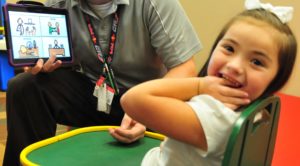We think this article from Autism Speaks about autism and speech generating devices is so valuable, we thought we’d share it with you.
about autism and speech generating devices is so valuable, we thought we’d share it with you.
——
A parent asks, “Our son is 6 years old, minimally verbal and on the spectrum. We’ve seen him make progress with a speech-generating device – a touch screen with pictures that produce single words. How can we use this approach to keep him making progress and meet his changing needs as he gets older and becomes more independent of us?”
1. For your child to take full advantage of a speech-generating device, he will need instruction from someone who is versed in a well-researched and effective approach such as the two I mention in above. It’s not enough to just put a device in front of a child. Where to find a speech-language therapist with AAC background here.
2. There is no single best speech-generating device or app for autism. Individuals with autism vary greatly in their needs and learning profiles. Work with your child’s speech-language therapist to develop individualized solutions for your child.
3. Whenever possible, choose devices and apps that are supported by research evidence and have documented success. The Autism Speaks Autism Apps database provides information on research supporting each app’s intended benefits.
4. Encourage your child to use his device outside of training sessions with his therapist. This should involve you and other communication partners and take place throughout the day.
5. Have a back-up means of communication for your child! Remember, batteries run down and electronic devices break down. This can be as simple as a communication board or picture exchange book.
6. Devices and apps can quickly become outgrown and outdated. Regularly review your child’s changing needs and new technology options–ideally with your child’s therapist or another expert.
To read the entire article, click here.
Source
Autism Speaks is dedicated to promoting solutions, across the spectrum and throughout the life span, for the needs of individuals with autism and their families through advocacy and support; increasing understanding and acceptance of people with autism spectrum disorder; and advancing research into causes and better interventions for autism spectrum disorder and related conditions.

